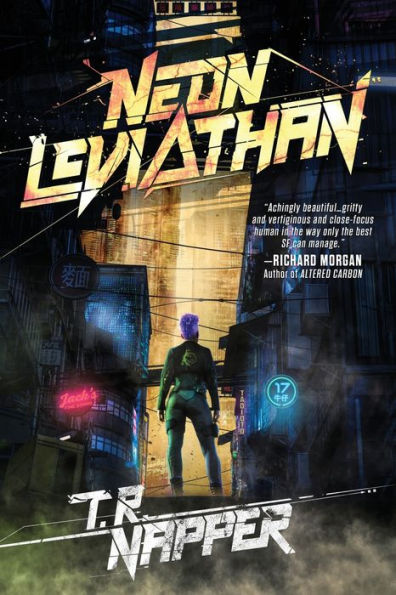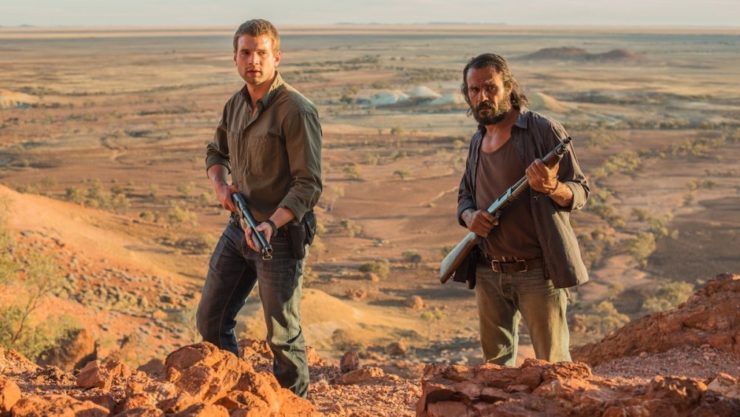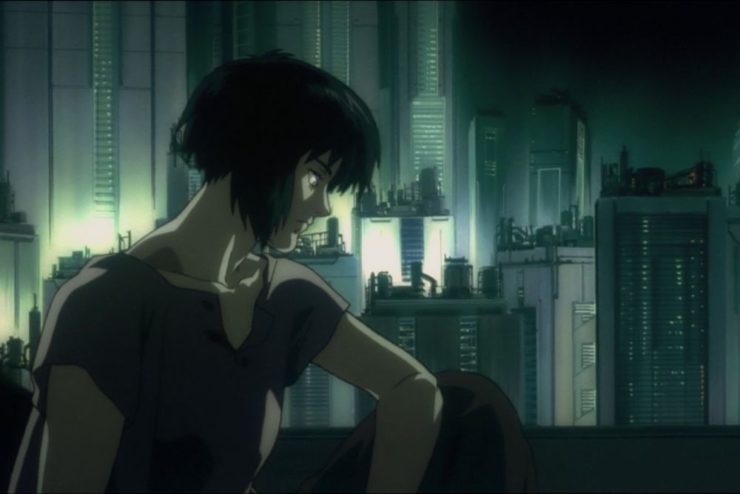I spent the three years of my doctorate defining noir and its direct descendant, cyberpunk, and their representations in film and literature outside of the US—in particular Australia, Japan, Hong Kong, and Vietnam. As an Australian who has lived throughout East and Southeast Asia for a decade as an aid worker, as a writer, and as an obsessive of hardboiled literature and the film Blade Runner, the task was a merging of all my professions and passions.
The origins of noir are briefly, and best, summarized by someone other than me. Noir scholar Phillipa Lovatt argues:
“Noir was transnational from the very beginning. Drawing on several cinematic traditions including German expressionism and French poetic realism, and combining them with the dark humour and brutality of the hardboiled pulp fiction of American writers such as Dashiell Hammett and Raymond Chandler, film noir has always been characterized by a sense of hybridity.”
Cyberpunk descends from noir, most obviously through Neuromancer (1982) and Blade Runner (1984), whose creators—William Gibson and Ridley Scott—acknowledged the central influence of noir writers Dashiell Hammett and Raymond Chandler.
Buy the Book


Neon Leviathan
Across noir, in the US and abroad, we see four archetypal protagonists, appearing time and again: the private eye (throughout noir, from the 1930s onward), the masterless samurai (in Japanese noirs), the gunslinger (also throughout noir, but in particular in Australian and Hong Kong noirs), and the android (in cyberpunk). Each the loner who works to their own, often opaque, code; who exists somewhere between the demimonde of the criminal underworld and ‘civilized’ society.
The transnational experience of modernity has both local and universal expressions in art. What links the global experience of US, Australia, Europe, East and Southeast Asia is rapid development, cultural loss, the alienating forces of economic capital, and the indifferent and corrupt rule of the Leviathan state. The Gunslinger, the Private Eye, the Samurai and the Android are modernity’s antagonists. They live at the margins of the law, of frontiers, and even what it means to be human. They walk the Earth amongst modernity’s casualties.
The narrative template of noir, with its origins in the hardboiled and disillusioning interwar period, offers a mood, tone, and critique of power that resonates across cultures and time.
Below represents my best efforts to summarize the distinct noir traditions of four countries. I am not claiming these to be the only local noir. However, I certainly believe the four traditions I have identified are significant.
Sunshine Noir: A Great Silence

Australian Sunshine Noir delivers social realism, rather than the stylized realism of US noir. Sunshine Noir takes place in the outback under an unblinking sun, rather than on the slick and mean streets of the dark city. The noise and fury of the urban centre is replaced by a great silence. Sunshine Noir critiques modernity through the eyes of two groups: first, Indigenous Australia, historically nearly wiped out by the colonial project, and contemporarily, often separated from language, land, and even family; second, the working class and poor, historically identified merely as expendable bodies for the English, and contemporarily as causalities of economic orthodoxy and class bigotry.
Sunshine Noir, as the title suggests, uses the environment as a central motif. There is a fear and sense of foreboding in the natural environment that rarely exists in other global noirs. In reviewing Australian Western noir, The Proposition (2005) (with an outlaw gunslinger as protagonist), Roger Ebert makes the following observation:
There is the sense [in Australian films] that spaces there are too empty to admit human content. There are times in “The Proposition” when you think the characters might abandon their human concerns and simply flee from the land itself.
In Sunshine Noir, the land is almost always presented as a hostile, barren, and pitiless place: in its vastness, a great silence.
The exception is when the protagonist is Indigenous, as with Jay Swan (played by Aaron Pederson), a cop returning to his land in the neo-noir movie Goldstone (2016); or Blackie, a recently-released criminal also returning to his land in Paul Collis’ novel, Dancing Home (2017). These characters are connected to and in communion with the land. For them, the existential horror comes not from the land, but from their knowledge of what the land once was, and their horror at what has been lost.
David Michôd’s twin neo-noir films The Rover (2014) and Animal Kingdom (2010) are a must-see for anyone wishing to understand and appreciate Australian noir. Michôd’s work is Hobbesian, in so far as it envisages a war of all against all, where the lives of Australia’s underclass are nasty, brutish, and short. The Rover (set in the future, ‘ten years after the collapse’), depicts a Mad Max-ian wasteland, where the land itself is reclaiming the continent, subsuming what is left of the built environment (if any of you have followed what climate change is currently doing to Australia, this vision feels disturbingly prescient). Almost every scene is in the stark sunlight, the characters looking for respite from its harshness. The protagonist Eric (played by the excellent Guy Pearce), like the environment, is spare in his words, desolate in his outlook, and merciless in his actions.
Throughout Australian noirs, the great silence of the Australian outback, of the sun-flattened empty streets of the suburbs, is the silence of the Australian soul. It is the desolation of the marginalized: an existential emptiness springing from a loss of identity and place, from the loneliness of standing against a corrupt system, or from an unjust world that has long left them behind.
Identity Noir: The Art of Forgetting and Remembering

Hong Kong noir is concerned with the nature of collective identity in the context of unrelenting geopolitical pressure. Once a British colony, now a ‘special administrative region’ in China, but never really part of either, Hong Kong identity has been forged under the pressure of great powers. Today, as China tightens its political grip on the city, as protests roil the streets, and as cherished freedoms—speech, artistic expression, association—that once made it distinct from the Mainland are disappearing, the Hong Kongese are increasingly seeking to imagine their common identity.
Hong Kong is unique insofar as it has an expiry date as a political entity: the ‘One-Country, Two-Systems’ agreement with China ends in 2047. The time-bound nature of its existence gives impetus—even a desperation—to Hong Kong’s search for identity. Amnesia and the fragility of memory—common tropes of noir—therefore have a particular resonance in Hong Kong cinema.
Hong Kong noir cinema focuses heavily on gunslinging cops, gangsters, and in particular undercover police (such as City on Fire (1987), Bullet in the Head (1990), and Hard-Boiled (1992)). One of the most notable is Infernal Affairs (known to Western readers through its Scorsese remake, The Departed). Anxiety around memory—consistent with many Hong Kong neo-noirs—is key to the Infernal Affairs.
Infernal Affairs has dual main characters: one an inspector, Chan Wing-yan (played by Tony Leung) working undercover in a triad gang; the other a criminal, Lau Kin-ming (played by Andy Lau), a triad mole in the Hong Kong Police Force. Both have lived these fake lives for a decade. Chan’s boss (Superintendent Wong) is the only one who knows the undercover officer’s true identity. Later in the film, when Wong is killed, Chan is desperate to recover his lost identity. At one point, when the undercover cop and the triad mole meet on a rooftop looking out over Hong Kong, Chan says: “I’m a cop.” To which Lau replies: “who knows?” Without collective memory, Chan’s claim to his identity is meaningless. Thus, when Chan is killed towards the end of the film, he has been collectively forgotten by the city of Hong Kong.
The story of Hong Kong is the story of noir. The fate of the city—to be subsumed politically into the mainland in 2047—seems inevitable, and this inevitability is met with a sense of sorrow and loss. Hong Kong’s experience of modernity is characterized, in particular, by its experience with colonialism and capitalism. Both have, without question, been transformative to the city, and both have, in different ways, torn the city away from its historical roots and propelled it into an uncertain future.
Android Noir: Modernity’s Unease

Ghost in the Shell (1995) is a landmark event of Japanese anime and global cyberpunk, a film that powerfully articulates contemporary fears about technology and its impact on our humanity. It explores the relationship between body and mind, between memory and identity, and between slavery and freedom. It also articulates ideas beyond these binary expressions, and hence beyond the duality so often expressed in Western thinking. Ghost in the Shell is a discourse about the fusion of genders, ethnicities, and nationalities into a single being; of the other within the self; about being simultaneously one and many.
The anime exemplifies a specifically Japanese manifestation of noir in two ways: first, in its exploration of how technology transforms society and the human body, and the awesome potential of this advancement for either good or evil; second, in its depiction of technology as both metaphor and a literal example of pervasive control. Metaphorically, through the sense of one’s body and labour no longer being one’s own, in being given over to an avaricious economic system, and literally, through our cyborg present, where the instruments of control and prostheses insinuate themselves into the day-to-day lives of us all.
Ghost in the Shell is based on the manga of the same name. The protagonist is Major Motoko, a public security agent working for ‘Section Nine’. The Major is a cyborg: she has a full cybernetic body (her ‘shell’), but her brain still has the original organic material and the memories of her human self. While she is treated as human by those around her, she does not own her own shell, or even the memories she forms while working for the government.
This expresses, among other things, the alienation caused by modernity: in the late stage capitalism depicted in Ghost in the Shell, the engine of economic growth has found ways to intrude into areas once unimaginable. She is a very physical person, insofar as she is the most accomplished fighter, assassin, and infiltrator in her unit. Her physicality is prominent in both film and manga. Yet, this core aspect of her character is not her own; her body is owned by the government.
Under the harsh glare of a neon-lit future in Japan, Ghost in the Shell explores the plight of humanity in an age of cyberpunk: an age that has come, that surrounds us, that intrudes on every facet of contemporary life. Smart phones, data mining, pervasive surveillance, automation; social credit schemes, deep fakes, fake news, server hacks, and all the rest. We are living in a science fictional world, and the ideas of Ghost in the Shell, grimly fumbling for human dignity among the cold hard certitudes of technological progress, are more important than ever.
Apocalypse Noir: An Impossible History
In the decades following the Vietnam War (which the Vietnamese call the American War), the literature of Vietnam was the literature of trauma. The most critically-acclaimed and widely-read works were those that dealt with the impossible history of the wars to end French colonialism and American neo-colonialism. The term impossible history has a double meaning here. The first is obvious: that of a poor, developing nation toppling the last vestiges of the French empire, and afterwards defeating the new, bright and shining empire of the United States at the peak of its power. The second meaning is more nebulous: the impossible personal experiences of veterans in an apocalyptic war with America. Of three million dead and more wounded in decades of brutal combat. The impossible trauma carried within these veterans, sometimes so acute it could not be remembered, amnesia striking those with dark histories too painful even to recall.
Vietnamese post-war literature often features the lives of veterans, which links it to noir in an important way. The ‘shell-shock cinema’ of the post-First and Second World Wars was a formative influence on classic noir, as was Post Traumatic Stress Disorder (PTSD) central to several neo-noir films focused on US Veterans of the war in Vietnam (think Scorsese’s classic neo-noir, Taxi Driver).
The Sorrow of War (1987) tells the story of Kien, a broken veteran who writes about his experiences in the war in order to come to terms with them. The structure of the novel is fractured, jumping backward and forward in time from Kien’s youthful pre-war idealism, to the blood-soaked fever dream of his ten years on the battlefield, to the present day as a shattered, mentally-ill writer. The Sorrow of War is, first and foremost, a novel of trauma, and ground-breaking because of this depiction of the veteran.
This is a seminal Vietnamese novel. Until its publication, American suffering had been imagined as exceptional. As scholar Dana Healy puts it, “the trauma of war has been resolutely claimed by the Americans as theirs alone.” Sorrow destroys the stereotype put forward by both the Vietnamese Government and the US entertainment industry: the Vietnamese soldier as a stoic, self-sacrificing, resolute foe; automatons fighting various imperialist invaders. As Bao Ninh said during an interview with an American veteran, several decades after the war: “We were human beings. That is what you must tell people. We were human beings.”
The Sorrow of War and many other novels of the post-war period overlap with noir because their concerns have long been the concerns of the noir discourse. These novels tend to be anti-hegemonic, insofar as they have mitigated against the dominant narrative of both the United States—which saw American suffering as exceptional, and of the Vietnamese regime—which denied the depth and pervasiveness of Vietnamese suffering altogether.
The veteran archetype, I believe, can be placed alongside the private eye, gunslinger, samurai and android as one of modernity’s antagonists. The veteran is used up, cast aside, by the caprice of great powers, by the manufactured march of history, by the indifference of a corrupt regime. They either serve their purpose in a dominant narrative, or their stories are erased, exiled, banned. While the Vietnamese literature of trauma may not always sync perfectly with noir, it nonetheless offers a thematic resonance wherein the consequences of trauma may be articulated with both an unflinching realism, and a despairing humanism.
T. R. Napper is an award-winning short story writer. His work has appeared in annual Year’s Best Anthologies, and in highly respected magazines in the US, the UK, Australia, and Singapore. His work has been translated into French, Hebrew, German, and Vietnamese. He is also a former diplomat and aid worker, having lived and worked throughout Southeast Asia for over a decade delivering humanitarian programs. He is a scholar of East and Southeast literature, and has a creative writing doctorate in Noir, Cyberpunk, and Asian Modernity. T. R. Napper’s debut collection, Neon Leviathan, is available now. He does not own a cat.










